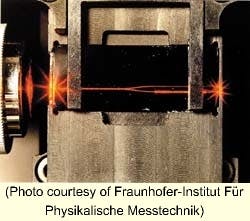The identification of proteins and other organic molecules is essential to medical research and diagnostics. In one important method of discovery and analysis, the immunoassay, organic substances are identified through their capacity to act as antigens. Conventional immunoassays rely on fluorescent dyes, radioactive isotopes, or other introduced chemicals as the agent of detection. But since organic substances can directly affect the propagation of light, identification methods can be based on measuring the phase velocity of an electromagnetic wave, eliminating the need for auxiliary chemicals. Scientists at the Fraunhofer-Institut für Physikalische Messtechnik (Freiburg, Germany) have developed such a technique, based on the most sensitive phase measurement technique of all: interferometry.
The chosen instrument is the Young's interferometer, which in its classic form consists of two slits. In order to maintain the form's rugged simplicity while providing an extended optical path of glass from which to make the measurements, the researchers built a waveguide version containing a beamsplitter and two terminated waveguide branches that serve as the slits (shown here filled with light from a helium-neon laser). A charge-coupled-device (CCD) camera placed some distance away captures the resulting interference pattern. With a silanized surface, one of the waveguide branches becomes the sensing arm; adsorption of the test substance on its surface causes the phase of light to shift relative to that in the reference arm. Because the CCD is capturing an entire fringe pattern rather than a single intensity value, electrical noise effects are reduced.
For test, the reference arm was continually rinsed with pure phosphate-buffered saline (PBS), while the sensing arm was washed with a solution of a protein (protein G at 0.2 mg/ml concentration) dissolved in PBS. The flow rate was 1 ml/s in both channels. Initially, the adsorption and immobilization rate of the protein is high, resulting in a large increase of the sensor signal on a time scale of seconds. The binding rate then grows smaller. Eventually, adsorption and desorption rates become equal, producing a constant sensor output.
One problem with the measurements was a lack of adsorption consistency that depended on the amount of silanization of the sensing arm surface. "Protein G is just a test reaction," says Albrecht Brandenburg, one of the researchers. "Future applications will focus on drug discovery and diagnostics." For these applications, he notes, specific immobilization techniques will have to be developed or improved upon.

